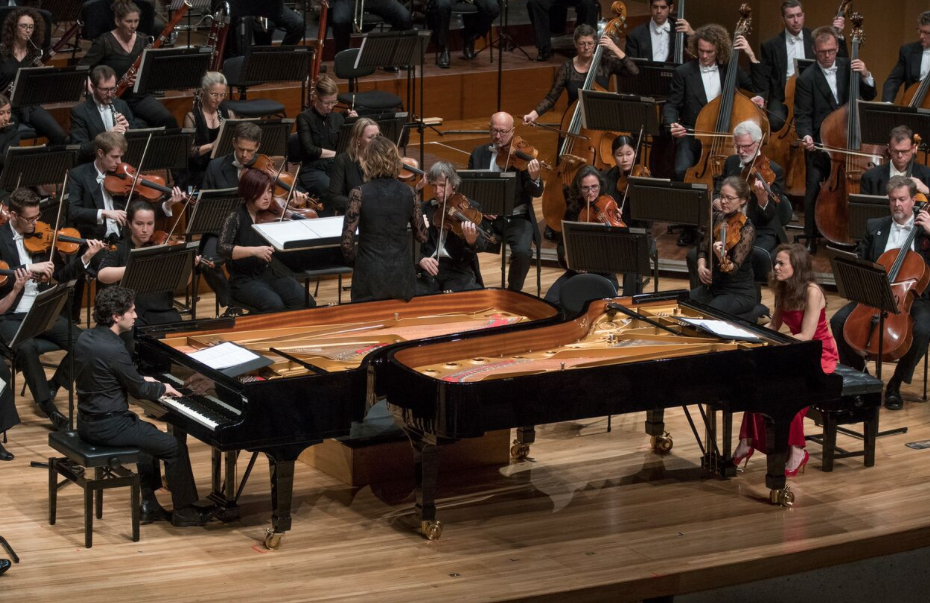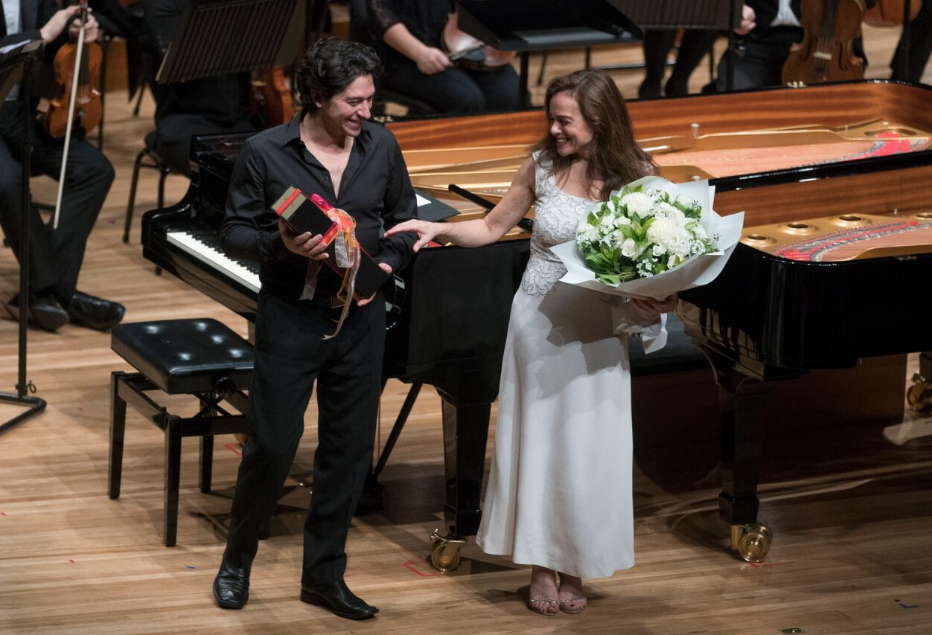This evening’s concert was originally programmed to showcase international guest guitarist, Milos Karadaglić, making his Australian debut, but an unfortunate injury forced him to withdraw from his entire international tour in 2017. This was a disappointment but fortuitously the Queensland Symphony Orchestra was able to attract South American piano Duo Lechner Tiempo in his stead, to play the acclaimed Jusid Tango Rhapsody in its Australian premiere. With this addition, the programme became strongly based around Latin and Central American musical styles and themes, alongside Malcom Williamson’s Our Man in Havana orchestral suite and two glorious pieces by Mexican composer Silvestre Revueltas.
 Duo Lechner Tiempo, Alondra de la Parra and the Queensand Symphony Orchestra. Photo © Peter Wallis
Duo Lechner Tiempo, Alondra de la Parra and the Queensand Symphony Orchestra. Photo © Peter Wallis
Based on the novel by Graham Greene, Williamson’s opera Our Man in Havana, is a rich eclectic musical mix, displaying Cuban inspired dance rhythms alongside easy-listening music of the 1950s. The orchestral suite, with its medley of the opera’s highlights, opens with some trademark neoclassical writing, lending the music a distinct sense of danger, perfect for its espionage theme. Under Alondra de la Parra’s leadership, the orchestra entered with gusto into the spirit of the piece, injecting strong Latin rhythmic sounds with bongo drums, castanets, lush strings and harmonic brass into the overall rich score. They clearly were having great fun and it was the perfect opener to the evening.
South American siblings, pianists Karin Lechner and Sergio Tiempo, enjoy distinguished international solo careers on concert platforms around the world. They also regularly play together as the Duo Lechner Tiempo, and commissioned Tango Rhapsody from Argentinian composer, Frederico Jusid, in 2014 as a concerto for two pianos and orchestra. A fiery tango-inspired story, based on the demotic music of the slums in Buenos Aires, the work is cinematic in structure with short scenes based on traditional dance themes such as love, jealousy, yearning, anger, tenderness. The pianists show off virtuosity and dazzling technique around the passions displayed in the narrative, in a way that perhaps only tango as a dance form can demonstrate. As an inventive device, it was certainly entertaining and riveting to watch, as the pianists face off against each other, often moving around the stage and entering and exiting at key moments. Clever and beautifully presented with each artist in total control, this was a brilliant piece of showmanship from two fine young pianists who gave us an entirely fresh way to look at composition and delivery. They followed it with a stunning encore of a skilfully freestyled variation on Paganini’s Variations for two pianos which was perfectly played and technically assured.
 Karin Lechner and Sergio Tiempo. Photo © Peter Wallis
Karin Lechner and Sergio Tiempo. Photo © Peter Wallis
Revueltas’ Sensemayá and The Night of the Mayas, are two of his most popular and accessible works. Alondra de la Parra introduced both pieces briefly, explaining instruments and their characters, in the way of Prokofiev’s Peter and the Wolf, a concept which was embraced warmly by the audience.
Sensemayá, a story of the ritualistic killing of a snake, is graphically portrayed in the atmospheric and colourful music. Commencing with throbbing percussive undertones, the piece offers great work for brass, particularly tuba and horns, with its dramatic rhythms and climatic ending. It is a delicious and enjoyable piece.
The Night of the Mayas, a four-movement symphonic suite, was probably the highlight of the evening. The filmic, sweeping music is dramatic but with lush, lyrical passages offering opportunities for all sections of the orchestra to excel. The ritual procession of the first movement was dominated by well-controlled brass, trumpets and trombones, with a powerful lyrical passage that offered excellent horns, wind and a plaintive first violin. The second scherzo movement, Night of Revelry, introduced both marimba and mariachi sounds as well as the caracol to great effect, with some solid Latin rhythms in the brass and darker strings. Night of the Yucatan is a dark and sombre movement with a marvellous trembling flute solo and heartfelt violins and strings, full of colour and depth. The final Night of Enchantment builds to the climatic finish of the Mayan ritual with its repetitive, discordant percussion and mounting tension in the dark strings and brass. This was thrilling, charismatic and brilliantly executed music.
As to be expected, the QSO’s Music Director, Mexican born Alondra de la Parra, was totally at home with both the style and rhythms of this Latin-inspired programme and she injected a joyful energy and passion into her conducting, which was exciting to watch. The orchestra embraced this new world music with equal enthusiasm, clearly playing instruments which many may never have played before. It was a privilege to hear such delightfully rich music, with which we are unfamiliar, played so enthusiastically and at such a high level of proficiency.











Comments
Log in to join the conversation.